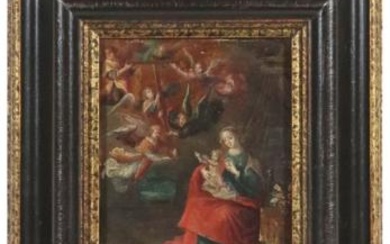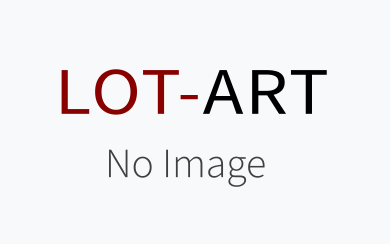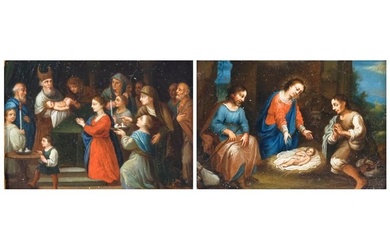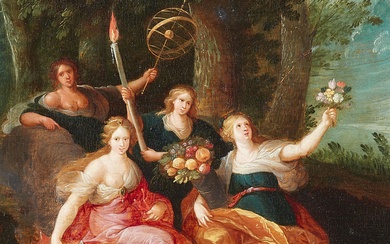Circle of FRANS FRANCKEN II (Antwerp, Belgium, 1581 - 1642).
Circle of FRANS FRANCKEN II (Antwerp, Belgium, 1581 - 1642).
"The Lender"
Oil on panel.
Circle of FRANS FRANCKEN II (Antwerp, Belgium, 1581 - 1642).
"The Moneylender
Oil on panel.
Measurements: 25,5 x 33,5 cm.
Work framed within the Flemish Baroque, which due to its stylistic characteristics can be related to the circle of Frans Francken II. The most fruitful of his family of painters, he trained with his father, Frans Francken I, and in 1605 he joined the Painters' Guild of Saint Luke in Antwerp, thus beginning a career that would last until 1640, in which he specialised in cabinet painting. His contribution to this genre was of great importance and influenced artists such as Teniers. His style is based on that of Jan Brueghel de Velours, although it is also strongly influenced by his father and his uncle, Hieronimus Francken. His early works reveal debts to Mannerism and 16th-century painting, both in the structure of the compositions and in the rhythm and expression of the figures. They also include clear references to the work of Italian artists such as Raphael, Veronese and Zuccaro. Similarly, the use of prints by Dürer and Lucas of Leyden for some of the figures has been demonstrated. In addition to cabinet painting, Francken painted mythological and biblical subjects, some altarpieces and, in collaboration with other artists, painted figures in landscapes or interior scenes by Tobias Verhaecht, Joos de Momper II, Pieter Neefs and Paul Vredeman de Vries, among others. He is currently represented in the most important art galleries in the world, such as the Prado Museum, the Louvre, the Royal Museum of Fine Arts in Antwerp, the Kunshistorisches Museum in Vienna, the Hermitage in St. Petersburg and the Royal Collection in London, among many others.
In particular, it is close to the work of Francken's last period. From 1630 onwards the artist evolved towards compositions in which local colour gave way to general, often brown tones, following both the style of Rubens and that of the contemporary Netherlandish school.
View it on
Estimate
Time, Location
Auction House
Circle of FRANS FRANCKEN II (Antwerp, Belgium, 1581 - 1642).
"The Lender"
Oil on panel.
Circle of FRANS FRANCKEN II (Antwerp, Belgium, 1581 - 1642).
"The Moneylender
Oil on panel.
Measurements: 25,5 x 33,5 cm.
Work framed within the Flemish Baroque, which due to its stylistic characteristics can be related to the circle of Frans Francken II. The most fruitful of his family of painters, he trained with his father, Frans Francken I, and in 1605 he joined the Painters' Guild of Saint Luke in Antwerp, thus beginning a career that would last until 1640, in which he specialised in cabinet painting. His contribution to this genre was of great importance and influenced artists such as Teniers. His style is based on that of Jan Brueghel de Velours, although it is also strongly influenced by his father and his uncle, Hieronimus Francken. His early works reveal debts to Mannerism and 16th-century painting, both in the structure of the compositions and in the rhythm and expression of the figures. They also include clear references to the work of Italian artists such as Raphael, Veronese and Zuccaro. Similarly, the use of prints by Dürer and Lucas of Leyden for some of the figures has been demonstrated. In addition to cabinet painting, Francken painted mythological and biblical subjects, some altarpieces and, in collaboration with other artists, painted figures in landscapes or interior scenes by Tobias Verhaecht, Joos de Momper II, Pieter Neefs and Paul Vredeman de Vries, among others. He is currently represented in the most important art galleries in the world, such as the Prado Museum, the Louvre, the Royal Museum of Fine Arts in Antwerp, the Kunshistorisches Museum in Vienna, the Hermitage in St. Petersburg and the Royal Collection in London, among many others.
In particular, it is close to the work of Francken's last period. From 1630 onwards the artist evolved towards compositions in which local colour gave way to general, often brown tones, following both the style of Rubens and that of the contemporary Netherlandish school.







